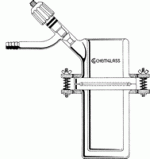I am working on a DMT sublimation project. A friendly glassblower can make a copy of Chemglass sublimator (see picture). As a coolant I can use ice or dry ice+acetone. I may even try liquid nitrogen, if necessary.
I am not sure how good vacuum I would need. For the moment my only source of vacuum is a water aspirator, but, if necessary, I can buy a rotary vane or membrane pump.
Does anybody know what pressure is required for DMT to sublimate? Does anybody have first-hand experience with sublimation? Any input would be much appreciated.
I am not sure how good vacuum I would need. For the moment my only source of vacuum is a water aspirator, but, if necessary, I can buy a rotary vane or membrane pump.
Does anybody know what pressure is required for DMT to sublimate? Does anybody have first-hand experience with sublimation? Any input would be much appreciated.

